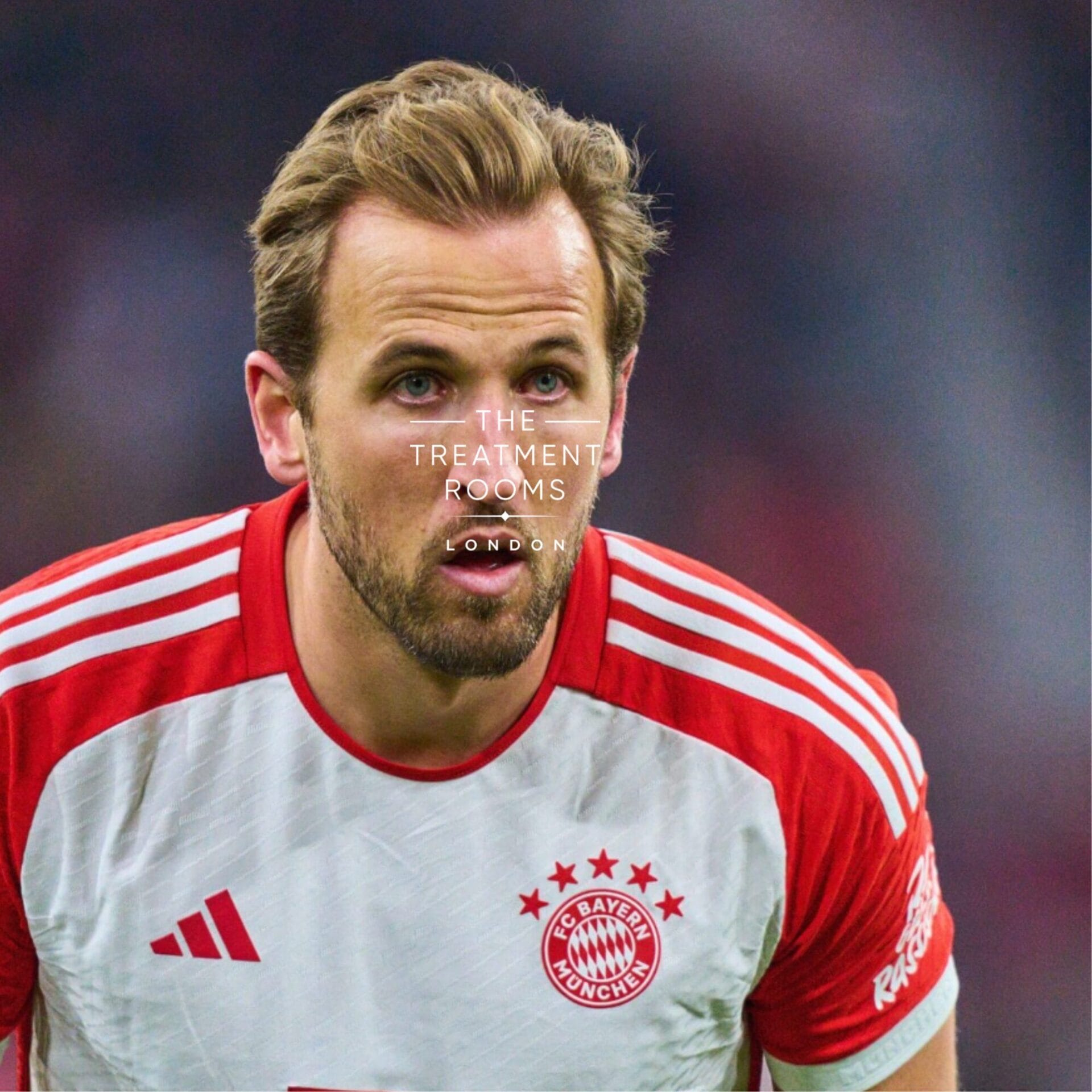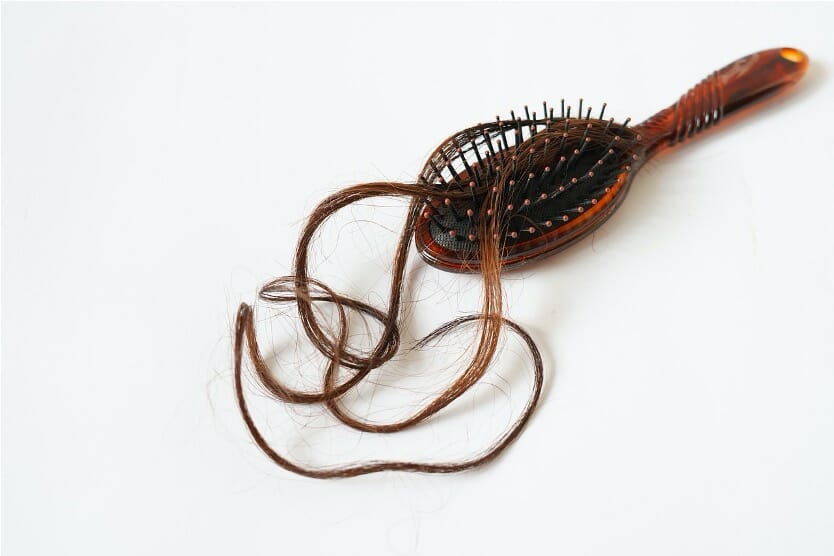Hair shedding after pregnancy isn’t the same as female pattern baldness, but it is a condition called postpartum telogen effluvium that impacts nearly all postpartum mothers.
Quick Summary: Hair Loss After Pregnancy
The hair has a natural life cycle that is comprised of three phases: active growth, transition, and resting. When a woman is pregnant, her hair stays in the active growth phase for an extended period of time. This is part of the “pregnancy glow”, giving women fuller, more luxurious hair as their pregnancy progresses. After childbirth, the same hormones that kept the hair in the active phase for so long plummet, leading to large volumes of hair loss. Many postpartum women report losing more than 100 strands of hair per day within 3-4 months of childbirth.
Hair Loss Versus Postpartum Hair Shedding
Postpartum hair loss is the reversal of gained hair in a typical 6 months period after pregnancy. This differentiates postpartum hair shedding from true hair loss because the hair lost in the postpartum period typically grows back. For many women, however, the volume of hair lost in the months following childbirth can be shocking and concerning. It’s important to note that postpartum hair shedding is a normal process and that the hair grows back in most cases.
3 Phases are Critical to the Normal Life Cycle of Hair
Hair has a natural, normal life cycle consisting of three phases. The first of these phases is the anagen phase, in which hair is actively growing. Up to 90% of the hair is in the anagen phase at any given time. The second phase is the catagen, or transitional, phase; during this phase, the hair follicles begin to shrink. In the third phase, known as the telogen or resting phase, the follicle releases the hair and it falls out. In a non-pregnant person, the hair is constantly going through these three phases. In pregnancy, however, hormone shifts cause disruption in the normal hair cycle.
Why Does Hair Shed After Pregnancy?
During pregnancy, a myriad of hormones control the maternal adaptation needed to support the growing foetus. These hormones shift as pregnancy progresses. In the third trimester of pregnancy, oestrogen surges, and this increase of oestrogen is responsible for the prevention of normal hair shedding. Increased oestrogen places the hair in the anagen phase, which explains why many women have beautiful, voluminous hair towards the end of their pregnancies. During this period, women find their hair to be thicker, and that’s because all of their hair is in the active growing pregnancy phase. These increased oestrogen levels do not last, though. At the end of pregnancy, oestrogen levels plummet. As this happens, the hair is suddenly shifted to the telogen phase causing the hair gained during pregnancy to shed.
When Does Hair Shedding After Pregnancy Happen?
During the first few months after childbirth, the hair will remain thick and full of volume. There might be minimal hair shedding during this period. Sometime between three and four months postpartum, however, noticeable shedding begins and often will intensify. The postpartum woman might notice that she’s losing increased amounts of hair and even handfuls of hair in this period. It’s common for a woman to lose more than 100 strands of hair per day beginning at just 3-4 months postpartum.
When Does Postpartum Hair Loss Stop?
The postpartum woman loses more than 100 strands of hair for a few months after the process of shedding begins. Most women notice that the shedding will slow down within 6 months of onset.
How to Stop Hair Shedding After Birth
Postpartum hair loss is a natural process governed by hormones. As these hormones balance after childbirth, hair shedding will occur and then stabilise once the hormones revert back to their pre-pregnancy levels. This is a process that cannot be prevented or cured. There is no way to stop postpartum hair loss before it begins, but with a few simple recommendations at hand, postpartum women can successfully manage the months of postpartum hair loss.
How to Manage Postpartum Hair Shedding
Postpartum hair shedding is a temporary condition. While it can’t be prevented, hair loss after pregnancy can be treated in a way to yield the best possible outcome. One of the most important aspects of postpartum hair loss is to keep the hair as healthy as possible. This can be achieved through gentle handling. Women should take care to gently brush their hair and avoid the application of heat as much as possible. Women should also avoid harsh chemical treatments and colouring during this time. The use of volume-enhancing hair products such as shampoos and conditioners designed to add volume can help achieve a more full look. Moreover, women can also opt for a hair style or cut that lends to volume, such as added layers. It is also important to optimise your diet to ensure your hair receives the correct nutrients for growth, these can be Vitamin D, A, C, B12, Iron and Biotin.

When to See a Professional About Hair Loss After Pregnancy
Hair loss after shedding tends to wane after about six months of onset. If a woman continues to lose large amounts of hair past this point, or if she has growing concern about the hair she is losing within this time frame, then she should schedule an appointment with a professional to rule out underlying causes or create a treatment plan for procedures such as female hairline lowering transplant. In most cases, postpartum hair loss will resolve on its own, and the lost hair will grow back.
Conclusion
Hair shedding after pregnancy is a common concern for women who’ve recently given birth. In nearly all cases, the hair lost during this period will grow back before the child reaches one year old. In cases where the hair loss is concerning to the woman, or if the hair loss continues beyond the one year point, women can seek the consultation of a professional to help rule out any potential underlying conditions that could be exacerbating their hair loss. If you are concerned about hair loss after having a baby, contact a physician to further discuss your options.
References
- Hair loss in New Moms. American Academy of Dermatology. (n.d.). https://www.aad.org/public/diseases/hair-loss/insider/new-moms
- Mirallas, O., & Grimalt, R. (2016, May). The postpartum telogen effluvium fallacy. Skin appendage disorders. https://pmc.ncbi.nlm.nih.gov/articles/PMC4908443/
- Postpartum hair loss: Causes, treatment & what to expect. Cleveland Clinic. (2024, May 1). https://my.clevelandclinic.org/health/diseases/23297-postpartum-hair-loss
- Vara, D. R. (2022, June 7). An in-depth guide to Female Pattern Baldness. Treatment Rooms London. https://www.treatmentroomslondon.com/hair-loss/female-pattern-hair-loss-what-you-need-to-know/
- Vara, D. R. (2024, August 5). Female hairline lowering transplant – hair transplant specialists. Treatment Rooms London. https://www.treatmentroomslondon.com/fue-hair-transplant-surgery/female-hairline-lowering-transplant/
Share:
Authored by
Reviewed by
Book a Consultation
Related Blogs
Folic Acid and Hair Loss
March 12, 2025
Quick Summary Hair loss is a widespread concern that affects millions of people globally. While genetics, hormonal…
Andros Townsend Transplant: Before, After, and His New Hairline
March 11, 2025
He’s best known for his days spent kicking a ball around, but Premier League footballer Andros Townsend…
Harry Kane Hair and Hairline
March 11, 2025
Harry Kane has suffered from a common condition of hair loss called male pattern baldness. This has…
Joe Swash Transplant: Before, After, and His New Hairline
March 11, 2025
Former ‘EastEnders’ actor and ‘I’m a Celebrity’ contestant Joe Swash has spoken very candidly about receiving multiple…
Guide To Finasteride For Hair Loss
March 4, 2025
One of the main effective medications in treating hair loss is Finasteride, which is often prescribed to…
When Can You Safely Wear a Beanie After a Hair Transplant?
March 1, 2025
Quick Summary Cap Recommendations: Light, breathable caps like snapbacks or trucker’s caps are advisable if you need…
Dutasteride and Hair Loss
February 23, 2025
Dutasteride is a medication that can be prescribed to men suffering from male pattern hair loss (androgenic…
Receding Hairline In Women – What You Need To Know
February 20, 2025
Quick Summary What is a Receding Hairline? In women, a receding hairline is often more subtle than…
Norwood 2 Hair Loss And Hair Transplants
February 20, 2025
Norwood 2 is a specific stage of hair loss that forms part of the Norwood Scale. During…










